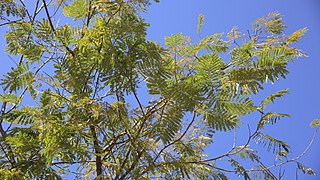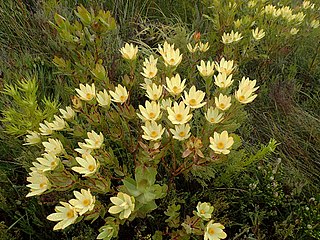
Herring are forage fish, mostly belonging to the family Clupeidae.
The Cypriot mouse is a species of mouse endemic to Cyprus. Its primary habitat seems to be the vineyards and fields of the Troödos Mountains region.
This article is a list of biological species, subspecies, and evolutionary significant units that are known to have become extinct during the Holocene, the current geologic epoch, ordered by their known or approximate date of disappearance from oldest to most recent.
Leucochloron foederale is a species of flowering plant in the family Fabaceae. It is found only in Brazil.

Leucochloron is a genus of flowering plant in the family Fabaceae. It belongs to the mimosoid clade of the subfamily Caesalpinioideae.
Euplassa occidentalis is a species of plant in the family Proteaceae. It is endemic to Ecuador.
Leucadendron nobile is a species of plant in the family Proteaceae. It is endemic to South Africa.
Roupala brachybotrys is a species of plant in the family Proteaceae. It is endemic to Ecuador.
Bat Conservation International (BCI) is an international nongovernmental organization working to conserve bats and their habitats through conservation, education, and research efforts.

The World's 25 Most Endangered Primates is a list of highly endangered primate species selected and published by the International Union for Conservation of Nature (IUCN) Species Survival Commission (SSC) Primate Specialist Group (PSG), the International Primatological Society (IPS), Global Wildlife Conservation (GWC), and Bristol Zoological Society (BZS). The IUCN/SSC PSG worked with Conservation International (CI) to start the list in 2000, but in 2002, during the 19th Congress of the International Primatological Society, primatologists reviewed and debated the list, resulting in the 2002–2004 revision and the endorsement of the IPS. The publication was a joint project between the three conservation organizations until the 2012–2014 list when BZS was added as a publisher. The 2018–2020 list was the first time Conservation International was not among the publishers, replaced instead by GWC. The list has been revised every two years following the biannual Congress of the IPS. Starting with the 2004–2006 report, the title changed to "Primates in Peril: The World's 25 Most Endangered Primates". That same year, the list began to provide information about each species, including their conservation status and the threats they face in the wild. The species text is written in collaboration with experts from the field, with 60 people contributing to the 2006–2008 report and 85 people contributing to the 2008–2010 report. The 2004–2006 and 2006–2008 reports were published in the IUCN/SSC PSG journal Primate Conservation,, since then they have been published as independent publications.

Leucadendron gandogeri, also known as cloudbank ginny, is a species of plant in the genus Leucadendron. It is native to South Africa. It typically grows in fire-prone shrublands.

Serruria adscendens is a species of flowering plant in the family Proteaceae, endemic to South Africa.

Spatalla confusa the long-tube spoon is a flowering shrub native to the Western Cape where it forms part of the fynbos. It is found in the Cederberg up to the Hottentots Holland Mountains, Swartberg and Kammanassie Mountains






